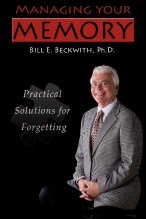Anything Given Less Than One Minute of Thought Will Fade From Memory
The most frequent question I am asked is “What can I do to improve my memory?” The answer depends upon which type of memory you want to improve. Practice, repetition, study, modeling, and imitation can all improve long-term memory. Long-term memory involves reinforcing what is already stored in the brain. It works like a muscle and strengthens and endures from use.
Short-term memory is a different issue. Short-term memory is the process of storing new information. It requires learning and is demonstrated by memory or skills that will be demonstrated at some future time. This memory system does not work like a muscle. It usually takes time and effort to learn new things. You remember best those things when you slow down, attend to, think about something. Hence anything given less than one minute of thought will fade from your memory – the One Minute Rule. Quit trying to remember. Plan how you will remember.
Memory training has been referred to as mnemonics or study skills, which require effort and strategy. These techniques allow deeper processing of information or skills and improve retention over time. Many of these techniques are simple and effective if used consistently.
Good organization improves memory. Clutter and disorganization interferes with memory. For example, have one place for notes. Having notes on random sheets of paper and in multiple locations increases the likelihood of forgetting. How many Post-it notes do you need to have before they fight each other? Create a memory notebook as the organized place to keep important notes and update it often.
A recent study (“The pen is mightier than the keyboard,” Psychological Science, 2014, Pam Mueller and David Oppenheimer) indicates that how you take notes will also determine how well you remember. They had students watch TED talks and take notes. Half took hand-written notes whereas the other half took notes by laptop computers. Students were asked both factual and conceptual questions about the material learned 30 minutes and one week later. Students who took hand-notes had better recall than those who took notes on their laptop. This advantage remained after one week even though both groups had studied from their notes.
Hand-notes appear to engage us more with the information. Many type faster than they write and therefore transcribe rather than make decisions about what to think about as they take notes. Just transcribing, verbatim notes, is not enough. This is a clear example of the One Minute Rule in Action.
Another example comes from an online article in The Philosopher’s Mail, “Why you should stop taking pictures on your phone and learn to draw.” The conclusion was based on the thoughts of John Ruskin, an English art critic. In essence, we are so busy taking pictures that we forget to look at the world whose beauty and interest prompted the picture. If you want to remember interesting things better, take the time to draw them irrespective of your talent for doing so. Drawing teaches us to see and notice properly rather than to gaze absentmindedly. It takes 10 minutes to sketch a beautiful tree but only a minute to gaze at the same tree.
The bottom line: spend the time and effort to improve your memory. Don’t forget the One Minute Rule.”




